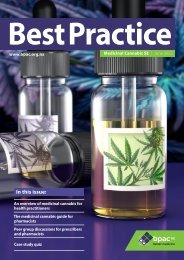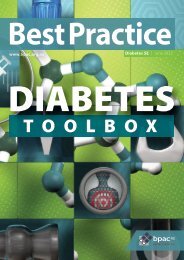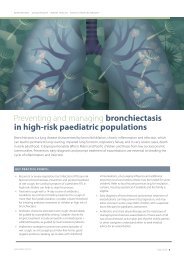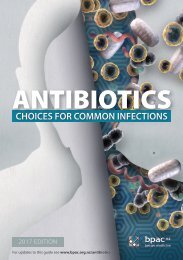Create successful ePaper yourself
Turn your PDF publications into a flip-book with our unique Google optimized e-Paper software.
Erythromycin can be used for patients with flucloxacillin allergy.<br />
Infections that are severe, persistent or recurrent usually<br />
require oral antibiotics. 8<br />
Routine use of oral antibiotics for uncomplicated ab<strong>sce</strong>ss does<br />
not improve treatment outcomes compared to incision and<br />
drainage alone. 9 There have been two randomised controlled<br />
trials (RCTs) recently that have challenged this recommendation,<br />
suggesting that oral antibiotics may provide a modest<br />
benefit to patients. 10,11 Two subsequent meta-analyses, which<br />
included data from these RCTs, have therefore also concluded<br />
that the use of antibiotics in patients with uncomplicated<br />
ab<strong>sce</strong>sses may improve cure rates. 12, 13 However, there has also<br />
been critique of these conclusions given the global issues<br />
with antibiotic resistance and that antibiotics can result in<br />
significant adverse effects for individual patients. 14 A pragmatic<br />
compromise has been suggested where antibiotics are only<br />
prescribed for patients who are considered high risk, e.g. those<br />
who are immunocompromised, have methicillin-resistant<br />
Staphylococcus aureus (MRSA) or a history of MRSA, systemic<br />
symptoms or who have limited access to follow-up. 14<br />
For further information for parents and caregivers, see:<br />
“Boils in children”, https://www.kidshealth.org.nz/boilschildren<br />
Topical antibiotics are not required for preventing infection<br />
following minor invasive procedures, e.g. removal of benign<br />
skin lesions. People aged over 75 years have one of the highest<br />
rates of topical fusidic acid use in New Zealand, and it is thought<br />
that using topical antibiotics as a preventative measure<br />
following the removal of benign skin lesions contributes to<br />
15, 16<br />
this high use.<br />
When should topical antibiotics be used?<br />
The main clinically appropriate use for topical antibiotics in<br />
New Zealand is the eradication of nasal carriage of S. aureus<br />
in patients with recurrent skin and soft tissue infections, or<br />
the eradication of MRSA, with the choice of topical antibiotic<br />
determined by su<strong>sce</strong>ptibility testing. However, the initial focus<br />
should be on optimising skin hygiene, e.g. antibacterial washes,<br />
avoiding sharing personal care items, and environmental<br />
decolonisation, e.g. frequent washing of linen and cleaning of<br />
regularly touched surfaces.<br />
If topical antibiotics are prescribed, include the intended<br />
duration of use so this will appear on the prescription label<br />
and prescribe just enough volume for the current condition.<br />
Encourage patients to discard the remainder of any tubes once<br />
treatment is completed, rather than keeping an unfinished tube<br />
for use on other occasions or by other household members.<br />
Further reading: two-part series on topical antibiotic use<br />
in New Zealand –<br />
“Topical antibiotics for skin infections: should they be<br />
prescribed at all”, available from: www.bpac.org.nz/2017/<br />
topical-antibiotics-1.aspx<br />
”Topical antibiotics for skin infections: when are they<br />
appropriate?”, available from:<br />
www.bpac.org.nz/2017/topical-antibiotics-2.aspx<br />
Patient information<br />
“Looking after your child’s skin”: a guide for parents and families,<br />
available from: www.health.govt.nz/system/files/documents/<br />
publications/skin-infections-booklet-nov13v2.pdf<br />
Kids Health skin infection resources, including information on<br />
specific conditions and resources in Māori, Samoan and Tongan<br />
languages, available from: www.kidshealth.org.nz/tags/skin<br />
References:<br />
1 Institute of Environmental Science and Research Limited (ESR). Antimicrobial<br />
su<strong>sce</strong>ptibility data from hospital and community laboratories, 2017. 2017.<br />
https://surv.esr.cri.nz/antimicrobial/general_antimicrobial_su<strong>sce</strong>ptibility.php<br />
2 Carter GP, Schultz MB, Baines SL, et al. Topical antibiotic use coselects for<br />
the carriage of mobile genetic elements conferring resistance to unrelated<br />
antimicrobials in Staphylococcus aureus. Antimicrob Agents Chemother<br />
2018;62. doi:10.1128/AAC.02000-17<br />
3 Lee AS, de Lencastre H, Garau J, et al. Methicillin-resistant Staphylococcus<br />
aureus. Nat Rev Dis Primers 2018;4:18033. doi:10.1038/nrdp.2018.33<br />
4 Ministry of Health. Pharmaceutical Claims Collection. <strong>2020</strong>.<br />
5 Roberts D, Leaper D, Assadian O. The role of topical antiseptic agents within<br />
antimicrobial stewardship strategies for prevention and treatment of surgical<br />
site and chronic open wound infection. Adv Wound Care 2017;6:63–71.<br />
doi:10.1089/wound.2016.0701<br />
6 Williamson DA, Carter GP, Howden BP. Current and emerging topical<br />
antibacterials and antiseptics: agents, action, and resistance patterns. Clin<br />
Microbiol Rev 2017;30:827–60. doi:10.1128/CMR.00112-16<br />
7 Francis NA, Ridd MJ, Thomas-Jones E, et al. Oral and topical antibiotics for<br />
clinically infected eczema in children: a pragmatic randomized controlled trial<br />
in ambulatory care. Ann Fam Med 2017;15:124–30. doi:10.1370/afm.2038<br />
8 Primary Care Dermatology Society. Folliculitis and boils (furuncles/carbuncles).<br />
2018.http://www.pcds.org.uk/clinical-guidance/folliculitis-an-overview<br />
(accessed 29 May 2018).<br />
9 Singer A, Thode H. Systemic antibiotics after incision and drainage of simple<br />
ab<strong>sce</strong>sses: a meta-analysis. Emerg Med J 2014;31:576–8. doi:10.1136/<br />
emermed-2013-202571<br />
10 Talan D, Mower W, Kirshnadasan A, et al. Trimethoprim-sulfamethoxazole<br />
versus placebo for uncomplicated skin ab<strong>sce</strong>ss. N Engl J Med 2016;374:823–32.<br />
doi:10.1056/NEJMoa1507476<br />
11 Daum R, Miller L, Immergluck L, et al. A placebo-controlled trial of<br />
antibiotics for smaller skin ab<strong>sce</strong>sses. N Engl J Med 2017;376. doi:10.1056/<br />
NEJMoa1607033<br />
12 Gottlieb M, DeMott J, Hallock M, et al. Systemic antibiotics for the treatment<br />
of skin and soft tissue ab<strong>sce</strong>sses: a systematic review and meta-analysis. Ann<br />
Emerg Med 2019;73:8–16. doi:10.1016/j.annemergmed.2018.02.011<br />
13 Wang W, Chen W, Liu Y, et al. Antibiotics for uncomplicated skin ab<strong>sce</strong>sses:<br />
systematic review and network meta-analysis. BMJ Open 2018;8:e020991.<br />
doi:10.1136/bmjopen-2017-020991<br />
14 Pulia M, Fox B. Clinical Controversies: Antibiotics should not be routinely<br />
prescribed following incision and drainage of uncomplicated ab<strong>sce</strong>sses. Ann<br />
Emerg Med 2019;73:377–8. doi:10.1016/j.annemergmed.2018.04.026<br />
15 Vogel A, Lennon D, Best E, et al. Where to from here? The treatment of impetigo<br />
in children as resistance to fusidic acid emerges. N Z Med J 2016;129:77–83.<br />
16 Williamson D, Ritchie SR, Best E, et al. A bug in the ointment: topical<br />
antimicrobial usage and resistance in New Zealand. N Z Med J 2015;128:103–9.<br />
www.bpac.org.nz<br />
Best Practice Journal – SCE Issue 1 17









